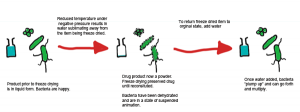I was flicking channels last night and came across an episode of Landline on the ABC. Being broadcast at the time was an article entitled “Smell The Roses”.
Of most concern to me were the following words I heard shortly after tuning in “…we actually freeze dry the rose petals, they’re taken down to minus 20 to minus 40 degrees, which means it kills off all potential bacteria, diseases…”
As a microbiologist with over 15 years experience within the pharmaceutical industry, I happen to know a thing or two about preservation processes and the above statement is incorrect.
One of the aseptic manufacturing lines where I worked included a freeze drying chamber. Once the product was filled, it passed into this chamber where all the water would be removed at a negative air pressure and at reduced temperature. This turned liquid drugs into a powder which could be stored theoretically forever before use. To make the powder ready for injection, all the administering doctor or nurse needs to do is add water. The process is explained in the diagram below. I apologize for it being a quick and nasty sketch that is not to polished and to scale.

The simplified freeze dried process (click to enlarge)
As the product was to be injected into humans, zero bacteria were allowed in the product and the surrounding manufacturing area. This meant that if a single bacteria was found on a swab, on a contact plate or in an air sample of the freeze drying chamber or associated areas, the batch was flagged. If two bacteria, or were recovered the batch would be placed on hold while I conducted an extensive investigation which would include such things as interviewing the manufacturing personal involved in the batch, the production operator and or microbiologists who took the sample, the microbiologist who processed the sample, the epidemiology of the recovered microbe, both within the manufacturing facility and the environment, viable environmental monitoring trends as well as conducting a risk assessment as to whether the microbes recovered were likely to have been introduced during sample processing, or were actually recovered from the filling room and what the risk to the end user was. If a bacteria was shown to have been present during production, and the presence could not strongly be explained away as a downstream contamination event, the batch (sometimes worth millions of dollars) would get a destruction recommendation.
While working with microbes, one of the preferred ways we transport them is by lyophillisation. This is a specialized form of freeze drying where we make use of cryo-protectant solutions to enhance the viability of the bacteria following revival. Such freeze drying preparations can preserve bacteria for years.
These are just two examples of why the statement that freeze drying “kills off all potential bacteria” is wrong. I could chat philosophically about what a potential bacteria is, but chatting about inaccurate or imprecise statements in science could fill another post.
It is important to note that this discussion applies to vegetative cells only. That is, bacterial cells that are living with the potential for reproduction. When it comes to non vegetative cells such as spores, the ONLY things that will kill them with any assurance is an autoclave (moist heat for extended period at elevated temperature and pressure) or a dry heat oven (elevated temperature with no water). Freeze drying has absolutely no effect on bacterial spores. Freeze drying would also kill any diseases the roses may have had as long as they are viral as the FD process would kill the plant cells, and thus render the any viruses unable to use the petals for reproduction. Whether or not the viral particles could infect any living rose plant tissue they subsequently come into contact with would make a fine experiment.
